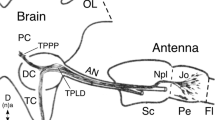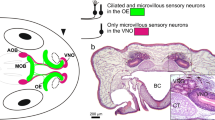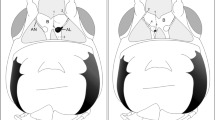Summary
The rhinophores of the veliger larva of Rostanga pulchra are located in the intravelar field near the base of the velar lobes. Each rhinophore is a cylindrical structure, tapering distally, and covered with a dense meshwork of microvilli. A conspicuous row of ciliary tufts runs along each side of the rhinophore and several stiffer tufts, composed of fewer cilia, are positioned around the tip or at the base. The rhinophoral epithelium consists of supporting cells, ciliated cells (giving rise to the ciliary rows), dendritic terminals (giving rise to the tufts around the apex), and sinuses containing occasional amebocytes. The lumen of the rhinophore is occupied by the rhinophoral ganglion and muscle cells that are oriented in two perpendicular planes. Cell bodies of the dendritic endings are located within the rhinophoral ganglion, which in turn joins into the optic and cerebral ganglia. Rhinophoral ganglionic neurons do not synapse with each other, but numerous neuromuscular synapses are found in the lumen of the rhinophore.
Morphological evidence suggests that the dendritic endings are chemoreceptors and the ciliated cells are possibly mechanoreceptors but are not functional at this stage in development. The functional role of the rhinophores is discussed in relation to larval behavior at settlement and metamorphosis.
Similar content being viewed by others
References
Agersborg HPK (1922) Some observations on qualitative chemical and physical stimulations in nudibranch molluscs, with special reference to the role of the “rhinophores”. J Exp Zool 36:423–445
Alkon DL, Akaike T, Harrigan J (1978) Interaction of chemosensory, visual, and statocyst pathways in Hermisseda crassicornis. J Gen Physiol 71:177–194
Altner H, Prillinger L (1980) Ultrastructure of invertebrate chemoreceptors, thermoreceptors and hydroreceptors, and it's functional significance. Intern Rev Cytol 67:69–140
Arey LB (1918) The multiple sensory activities of the so-called rhinophore of nudibranchs. Am J Physiol 46:526–532
Bickell LR, Chia FS (1979) Organogenesis and histogenesis in the planktotrophic veliger of Doridella steinbergae (Opisthobranchia: Nudibranchia). Mar Biol 52:291–313
Bonar DB (1978) Ultrastructure of a cephalic sensory organ in larvae of the gastropod Phestilla silbogae (Aeolidacea, Nudibranchia). Tissue Cell 10:153–165
Bonar DB, Hadfield MG (1974) Metamorphosis of the marine gastropod Phestilla sibogae Bergh (Nudibranchia: Aoelidacea). I. Light and electron microscope analysis of larval and metamorphic stages. J Exp Mar Biol Ecol 16:227–255
Chase R (1979) Photic sensitvity of the rhinophore in Aplysia. Can J Zool 57:698–701
Chase R, Croll R (1981) Tentacular function in snail olfactory orientation. J Comp Physiol 143A: 357–362
Chia FS, Koss R (1978) Development and metamorphosis of the planktotrophic larvae of Rostanga pulchra (Mollusca: Nudibranchia). Mar Biol 46:109–119
Chia FS, Atwood DG, Crawford BJ (1975) Comparative morphology of echinoderm sperm and possible phylogenetic implications. Am Zool 15:553–565
Chia FS, Koss R, Bickell LR (1981) Fine structural study of the statocysts in the veliger larva of the nudibranch, Rostanga pulchra. Cell Tiss Res 214:67–80
Cook ET (1962) A study of the food choices of two opisthobranchs, Rostanga pulchra MacFarland and Archidoris montereyensis (Cooper). Veliger 4:194–196
Crisp M (1971) Structure and abundance of unspecialized external epithelium of Nassarius reticulatus (Gastropoda, Prosobranchia). J Mar Biol Assoc UK 51:865–890
Crozier WJ, Arey LB (1919) Sensory reactions of Chromodoris zebra. J Exp Zool 29:260–310
Emery DG, Audesirk TE (1978) Sensory cells in Aplysia. J Neurobiol 9:173–179
Field LH, Macmillan DL (1973) An electrophysiological and behavioral study of sensory responses in Tritonia (Gastropoda, Nudibranchia). Mar Behav und Physiol 2:171–185
Harris LG (1975) Studies on the life history of two coral-eating nudibranchs of the genus Phestilla. Biol Bull Mar Biol Lab, Woods Hole 149:539–550
Kempf S, Willows AOD (1977) Laboratory culture of the nudibranch Tritonia diomedea Bergh (Tritonidae: Opisthobranchia) and some aspects of its behavioral development. J Exp Mar Biol Ecol 30:261–276
Kriegstein AR, Castellucci V, Kandel ER (1974) Metamorphosis of Aplysia californica in laboratory culture. Proc Natl Acad Sci USA 71:3654–3658
Laverack MS (1974) The structure and function of chemoreceptor cells. In: Grant PT, Mackie AM (eds) Chemoreception in marine organisms. Academic Press, New York, pp 1–48
Perron FE, Turner RL (1977) Development, metamorphosis and natural history of the nudibranch Doridella obscura Verrill (Corambidae: Opisthobranchia). J Exp Mar Biol Ecol 27:171–185
Richardson KC, Jarrett L, Finke EH (1960) Embedding in epoxy resins for ultrathin sectioning in electron microscopy. Stain Technol 35:313–323
Storch V, Welsch V (1969) Über Bau und Function der Nudibranchier-Rhinopheron. Z Zellforsch 97:528–536
Thompson TE (1958) The natural history, embryology, larval biology and post-larval development of Adalaria proxima (Alder and Hancock) (Gastropoda, Opisthobranchia). Phil Trans R Soc Lond (ser B) 242:1–57
Thompson TE (1962) Studies on the ontogeny of Tritonia homergi Cuvier (Gastropoda: Opisthobranchia). Phil Trans R Soc Lond (ser B) 245:171–218
Willows AOD (1978) Physiology and feeding in Tritonia I. Behavior and Mechanics. Mar Behav Physiol 5:115–135
Woher H (1967) Beiträge zur Biologie, Histologie und Sinnesphysiologie (insbesondere Chemorezeption) einiger Nudibranchier (Mollusca, Opisthobranchia) der Nordsee. Z Morp Okol 60:275–337
Wood RL, Luft JH (1965) The influence of buffer systems on fixation with osmium tetroxide. J Ultrastruct Res 12:22–45
Wright BR (1974a) Sensory structure of the tentacles of the slug Arion ater (Pulmonata, Mollusca). 1. Ultrastructure of the distal epithelium, receptor cells and tentacular ganglion. Cell Tissue Res 151:229–244
Wright BR (1974b) Sensory structure of the tentacles of the slug Arion ater (Pulmonata, Mollusca). 2. Ultrastructure of the free nerve endings in the distal epithelium. Cell Tissue Res 151:245–257
Zylstra U (1972) Distribution and ultrastructure of epidermal sensory cells in the fresh water snails Lymnaea stagnalis and Biomphalaria pfeifferi. Neth J Zool 22:283–298
Author information
Authors and Affiliations
Rights and permissions
About this article
Cite this article
Chia, FS., Koss, R. Fine structure of the larval rhinophores of the nudibranch, Rostanga pulchra, with emphasis on the sensory receptor cells. Cell Tissue Res. 225, 235–248 (1982). https://doi.org/10.1007/BF00214678
Accepted:
Issue Date:
DOI: https://doi.org/10.1007/BF00214678




